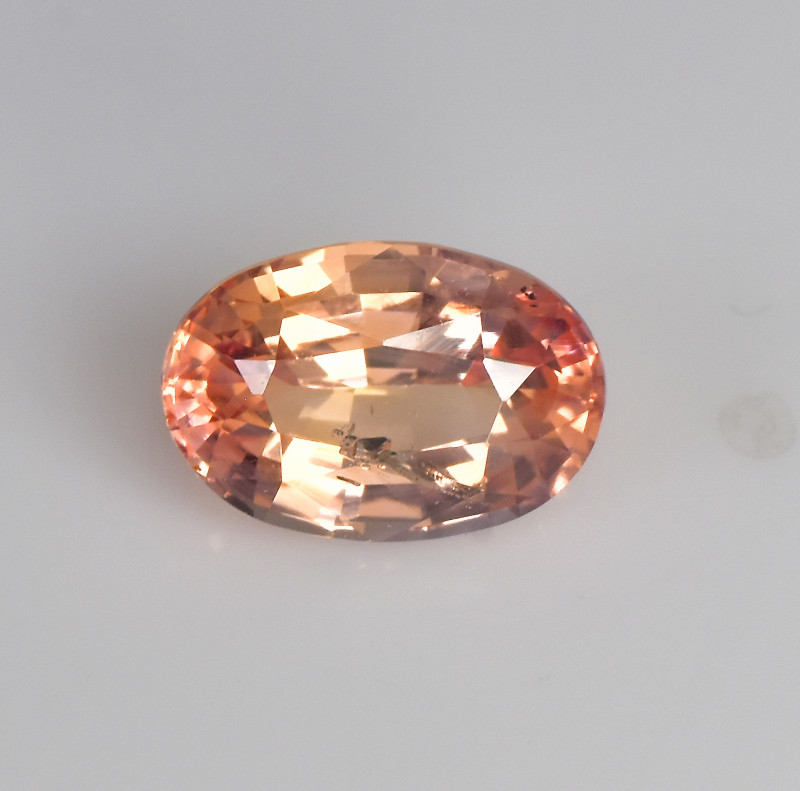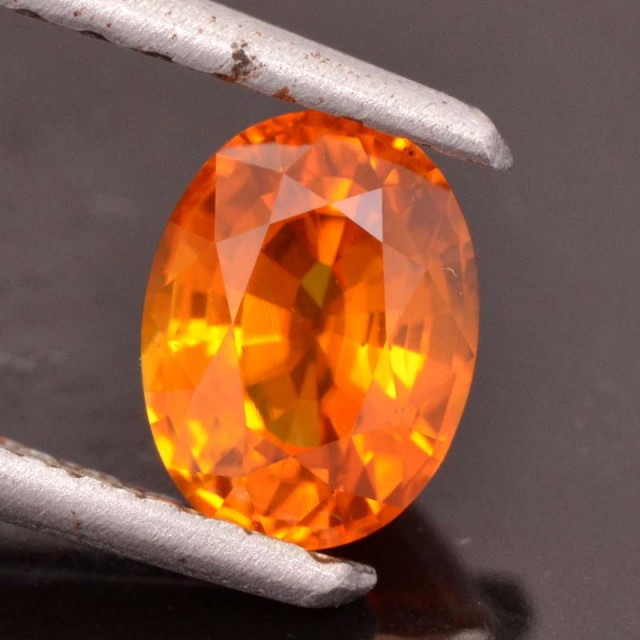
Orange Sapphire Gemstone: Properties, Meanings, Value & More
 Orange sapphire is a lesser-known color of the gemstone sapphire. But are orange sapphires real? Yes, these stones form naturally, though many on the market are synthetic or have been treated.
Orange sapphire is a lesser-known color of the gemstone sapphire. But are orange sapphires real? Yes, these stones form naturally, though many on the market are synthetic or have been treated.
Is an orange sapphire rare? Yes, natural, untreated orange sapphires are rare, only making up roughly 0.001 percent of the ones you’ll see for sale.
What is an orange sapphire called? Some may classify Padparadscha sapphires in this category, but there are notable differences that we’ll cover.
Though orange sapphires are rare, orange isn’t the rarest sapphire color. What is the rarest color of sapphire? The rarest sapphire color is the velvety blue Kashmir sapphire, though Padparadscha sapphires are a close second.
Ready to know more? Join us as we break down orange sapphire properties, benefits, prices, history, and more!

About Orange Sapphire Stone
Orange sapphire is a precious gemstone and “fancy color” sapphire, since it’s not blue.
All sapphires are September birthstones. November babies can celebrate too, as orange sapphire perfectly complements citrine, the traditional November birthstone.
Sapphires are traditional 5th, 45th, and 75th wedding anniversary gems and zodiac stones for the sign Taurus.
Orange Sapphire Specifications & Characteristics
As a type of corundum, orange sapphire is an aluminum oxide mineral. Ruby and sapphire are the two corundum varieties.
The mineral often forms barrel-shaped, flat-ended prismatic, or bipyramidal crystals. It can also be granular, massive, or rolled pebbles.
Orange sapphires with certain inclusions (parallel bunches of diaspore or rutile) can display asterism, an optical phenomenon creating star-like rays of light. These are orange “star sapphires.”
The remaining orange sapphire properties are:
Color: Shades of orange, including yellow, red, or brown undertones
Crystal structure: Hexagonal (trigonal)
Luster: Adamantine to vitreous (glassy)
Transparency: Transparent to opaque
Refractive index: 1.76-1.77
Density: 3.98-4.10
Cleavage: None
Fracture: Conchoidal
Streak: White
Luminescence: Fluorescence & X-ray colors present; Strong orange-red in LW-UV (natural); Very weak orange to red in SW-UV (synthetic); X-ray colors in some specimens from Sri Lanka, Kashmir, and Montana - dull red or yellow-orange
Pleochroism: Present & very strong in yellow-brown to orange/colorless
Birefringence: 0.008-0.009
Optical effects: Sometimes asterism
Dispersion: 0.018
 Pictured above: Padparadscha sapphire
Pictured above: Padparadscha sapphire
Orange Sapphire vs. Padparadscha Sapphire
Orange sapphires are considered Padparadscha sapphires to some, but the two differ.
Padparadscha sapphires are an incredibly rare sapphire named after the Sinhalese term padmaraṃga, meaning “lotus-colored” This African gemstone is somewhere between pink and orange, but the exact hue is the subject of much debate.
Various terms for describing Padparadscha sapphire’s color include:
Sunset
Sunrise
Apricot
Peach
Salmon
The Gemological Institute of America (GIA) claims Padparadscha sapphires should have a light to medium tone in orange-pink to pinkish-orange, with no brown undertones. The color should also be evenly distributed with no color-zoning.
According to a GIA survey, Western gemologists claim Padparadscha sapphires must be pastel. The same survey revealed that many buyers associated pink sapphires with purple undertones but Padparadscha sapphires with orange undertones.
We do know the color comes from iron and chromium, and higher chromium means pinker hues.
To summarize: Padparadscha sapphires differ from orange sapphires in having a pink-orange hue, and many gemologists argue that Padparadscha sapphires are pastel, while orange sapphires can be vibrant.
With that distinction covered, we’ll move into orange sapphire’s symbolism.

Orange Sapphire Meaning & History
Orange sapphires symbolize inspiration, bliss, and optimism. These stones are talismans for creatives, be it musicians, writers, designers, or otherwise. They’re also said to provide wisdom for decision-making and encourage empowerment.
History
The word “sapphire” has two possible etymological roots. One is the Ancient Greek sappheiros, meaning “blue stone,” relating to “sapphire” describing lapis lazuli and other blue gemstones until the Middle Ages.
Another possible origin is the Sanskrit śanipriya, meaning “sacred to Saturn,” relating to sapphire’s association with Saturn in Hindu astrology.
One major development of orange sapphire’s history occurred in 2001, when Australian gemologist Terry Coldham reported on a new treatment called beryllium diffusion for orange sapphires.
Coldham reported that a metallurgist in Thailand developed a method of treating Tanzanian sapphires to be bright orange to red-orange, leading to nicknames like “Sunset sapphire.”
The news came amid the appearance of huge quantities of so-called Padparadscha sapphires only labeled “heated” coming out of Thailand. By 2002, reputable gem labs realized beryllium had been diffused into the gems during heating.
In 2003, the Chanthaburi Gem and Jewelry Association responded by regulating that sellers must disclose the exact treatments.
Today, these beryllium-diffused orange sapphires are still widely available.

Orange Sapphire Healing Properties
Orange sapphires can be used as healing stones. As orange gemstones, these crystals can improve creativity, confidence, and charisma.
Additionally, orange sapphires are great sacral chakra stones, balancing the energy center to bring balance to your emotions and allow you to enjoy life fully.
Physical Healing
Physically, orange sapphires are said to treat or improve:
Fertility
Strength
Libido
Gland regulation
Blood disorders
Emotional Healing
The orange sapphire stone benefits anyone seeking greater creative self-expression. The sunny crystals are said to provide warmth and reassurance.
Additionally, orange sapphire can improve concentration by dispelling anxieties and encouraging you to follow your intuition.
As a gemstone, is an orange sapphire valuable? That depends on its quality.

Orange Sapphire Gemstone Properties
Orange sapphire’s value depends on its color, cut, clarity, carat weight, treatments, and natural vs. synthetic creation.
Color
Orange sapphire colors range from pale pastel shades to vibrant blood orange, often with yellow or brown undertones. The rarest, most valuable orange sapphires (outside Padparadscha) have a naturally vibrant orange hue free from undertones.
In nature, the color may come from chromium and iron impurities or exposure to natural radiation.
Cut
Orange sapphires are often faceted, with virtually any shape possible. Round or radiant shapes are common. Custom cuts are quite valuable, but all cuts should be proportional and symmetrical.
Star orange sapphires must be cut as cabochons to display their optical effect.
Clarity
Sapphires have a Type II colored gemstone clarity grade, meaning some small, visible inclusions are expected.
Common inclusions include:
Hexagonal color banding or growth lines
Fingerprints
Zircon crystals, often with dark “halo” fractures
More visible inclusions means lower value and often lower durability.
That said, natural orange sapphires are so rare that even those with minimal to moderate inclusions are fairly valuable.
Carat Weight
Natural orange sapphires in large sizes are scarce, especially ones with naturally good coloring. Therefore, larger gems have higher price-per-carat rates.
Treatments
Heat treatments (which improve color and/or clarity) are fairly standard for sapphires. Almost every orange sapphire available has been heated, so be sure to ask for a reputable gem laboratory report.
Less common but still prevalent is beryllium diffusion, which also uses heat and reduces blue tones. This treatment can turn dull or pale green to yellow sapphires into vibrant orange or yellow sapphires. Beryllium diffusion can also produce Padparadscha colors.
Another color treatment is irradiation, which can make colorless sapphires orange, but irradiated gems are less desirable.
For orange star sapphires, heat treatment is common for improving color and clarity, while diffusion treatment may be done to improve the “star.”
Avoid orange sapphires that have been fracture-filled or cavity-filled.
Synthetics
Synthetic orange sapphires are almost as common as treated ones, since the natural material is so rare. Common techniques are flux or flame fusion methods. These options are more flawless, budget-friendly, and sustainable.
Some consider the synthetics “fake” sapphire, but they have the same physical and chemical properties as their natural counterparts.
How can you tell if an orange sapphire is “real” or synthetic? The most sure-fire way is by having it tested by a gemologist. But under a microscope, some indicators are:
Bubbles
Flux inclusions
Curved striae
These synthetics also have more flawless clarity than natural stones.
Speaking of natural stones, how does orange sapphire form?

Orange Sapphire Formation & Sources
Corundum stones like orange sapphire form inside metamorphic or igneous rocks.
In igneous rocks, the stone crystallizes as the rock cools from magma. Longer cooling times creates larger crystals. The igneous rock must be aluminum-rich and silica-poor, like nepheline syenites.
In metamorphic rocks, the crystals form when ancient sea beds undergo metamorphism from hot, aluminum-rich waters.
Often, the rocks holding sapphires wear away, allowing water to carry the gems into alluvial deposits like riverbeds.
The orange hue occurs when chromium impurities combine with missing electrons (an “electron hole.”) Color zoning occurs when different chromophores take up different areas in the stone.
Mining Locations
Today, Australia and Madagascar are the top sources of orange sapphires. Sri Lanka and Tanzania are also significant.
In particular, orange sapphires from Umba Valley, Tanzania, are sometimes sold as Padparadscha sapphires, though they’re darker and browner than most gemologists could classify as Padparadscha.
Sapphires from areas in Tanzania, Vietnam, and Madagascar are frequently heat-treated to produce gorgeous “orange-juice” or “papaya” colors.

Orange Sapphire Price & Value
Orange sapphires aren’t always cheap, but they’re much more affordable than Padparadscha sapphires, which can reach $30,000 per carat.
Synthetic and treated orange sapphire stone prices are much lower than natural material, generally $8-$10 less per carat.
A loose orange sapphire gemstone ranges overall from $450-$10,000 per carat. The steeper prices are for larger stones with excellent clarity and color.
Lighter orange-yellow to yellow-orange sapphire price per carat ranges from $50-$750 per carat under 2 carats and $375-$1,625 per carat over 2 carats.
Orange star sapphires fetch $100-$300 per carat when 0.5-1 carat and $100-$500 per carat when 1-5 carats.
Orange Sapphire Care and Maintenance
Lastly, we’ll discuss gemstone care. Orange sapphires are super durable, great for daily wear. You may want protective settings for an orange sapphire ring, though.
However, orange sapphires colored by natural radiation may fade from daylight or heat over time, so keep that in mind.
Clean orange sapphire with the standard soft toothbrush, mild soap, and warm water.

Embrace Optimism with Orange Sapphire!
Blue may be most people’s favorite color, but orange truly makes a statement. Orange sapphires combine passion and positivity that will bring out your inner shine on even the darkest days!
Search the Gemstone Encyclopedia
Related Auctions
Related Articles
Originally the Birthstones or gemstones were associated with a zodiac sign or the month of a individuals birth. Find out what your stone is and view the stones we have for sale
8th Feb 2021
There are dozens of quartz and chalcedony gems with various colors and patterns. Learn all about quartz properties and every type of quartz, from amethyst and agate to plasma and phantom quartz!
15th Oct 2020
Hackmanite is a pink to violet sodalite gem known for its unique color-change and luminescence. Learn why hackmanite is special, from its rare qualities to the types of hackmanite jewelry available.
28th Mar 2018
Latest Articles
Yugawaralite is a rare colorless, white, or pinkish zeolite crystal named for its discovery in Yugawara, Japan. Here we uncover the multifaceted history, properties, prices, and uses of yugawaralite.
24th Mar 2025
Simpsonite is a lesser-known mineral known on the gem market for its durability, yellow-orange color, and rarity. Discover all the properties, uses, prices, and history of simpsonite.
3rd Mar 2025
Kurnakovite is a colorless crystal related to inderite and rarely faceted but known among collectors. Explore the mineral traits, history, prices, and more in this kurnakovite guide.
17th Feb 2025
Article Categories
How To's is where you will find helpful articles from gem Rock Auctions on how to cut gemstones, select gemstones and buy gemstones.
9 Articles





